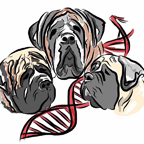
Bleeding disorders in a Mastiff, although uncommon, can occur. They can be congenital (genetic) or acquired (obtained).
Some Bleeding Disorders begin shortly after birth. In fact, when the umbilical cord is cut. Bleeding Disorders can occur from an illness, pregnancy, auto immune conditions, tick born diseases or certain cancers. Some diseases like Multiple Sclerosis, a Vitamin K deficiency or even one that is thought to be caused by drugs, mostly by a vaccination.
The body has 13 different clotting factors that run as a chain reaction to an injury. If any link in the 13 factor chain occurs, a dog is considered to have a bleeding disorder.
A mammal’s body has a natural process to stop bleeding called Hemostasis that engages platelets to an injured area. Hemostasis is a domino effect that evokes a coagulation (clotting) cascade. After an injury, the blood vessels shrink to slow blood flow and platelets come to help. They stick to one another creating a Platlet plug. The platelet plug gets thicker and spiney creating a Fibrin Plug to stop the bleeding.
Too few platelets or (Thrombocytopenia) can make clotting of an injury, internally or externally, either not as easy or life threatening depending on what Factor is malfunctioning.
There are also conditions of a clotting factor that causes the blood to clot too much. This blocks blood flow and can cause heart attacks, strokes or clots in the lungs.
Note: There is no way to diagnose or treat any kind of bleeding disorder without a Veterinarian and a blood test of the dog. So please do not attempt to on your own.
Detailed Description
"Bleeding Disorders of Dogs" by Susan M. Cotter, DVM, DACVIM, Cummings School of Veterinary Medicine, Tufts University provides a very detailed description of the bleeding disorders in dogs.References
- Susan M. Cotter, DVM, DACVIM, Cummings School of Veterinary Medicine, Tufts University. Bleeding Disorders of Dogs.
- Bleeding Disorders In Dogs – Blood Clotting Disorder Overview
Updated: 11/12/2024